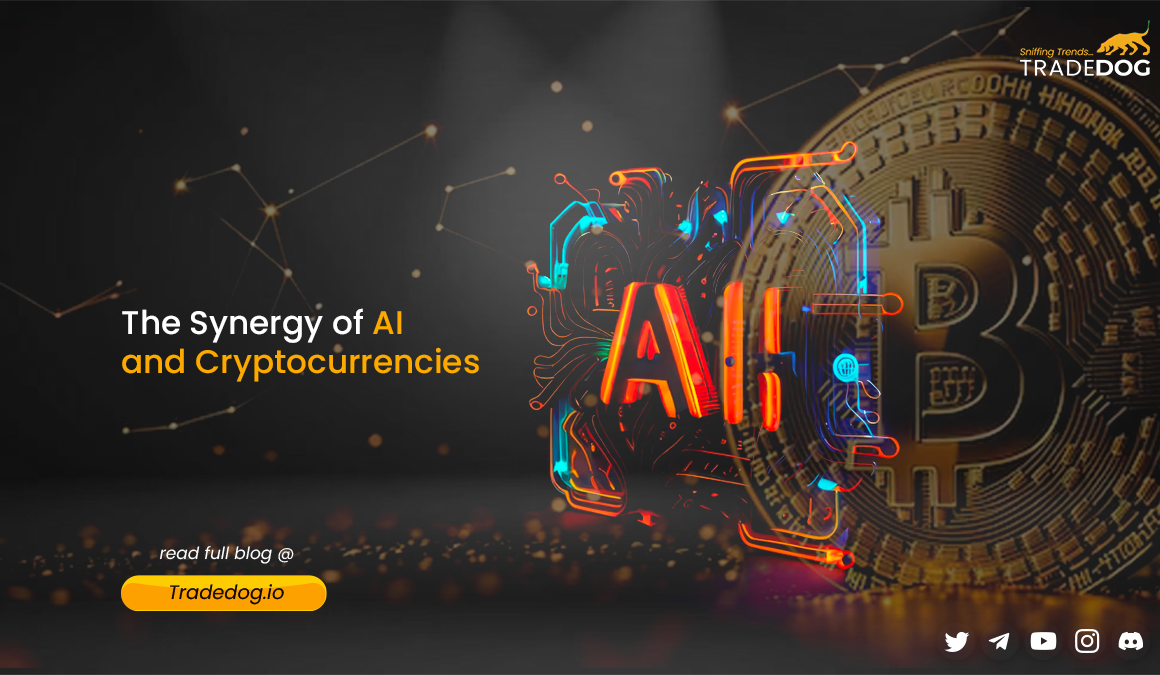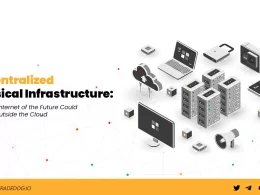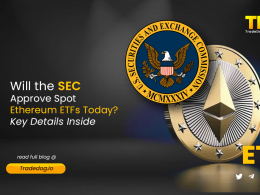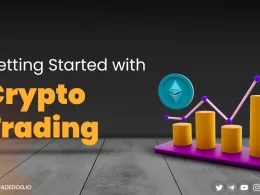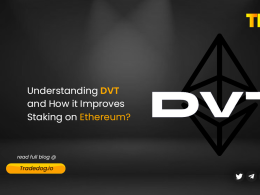Quick Links
In the era of technological evolution, the year 2023 stands out as a pivotal chapter, marking a monumental journey for artificial intelligence (AI). As the transformative power of AI became increasingly evident, the tech landscape witnessed a surge in innovation and adoption. This blog delves into the multifaceted developments that defined AI’s journey in 2023.
The Rise of AI Chatbots
The year 2023 witnessed an extraordinary proliferation of AI chatbots, with notable players like OpenAI’s ChatGPT, Google’s Bard, and Microsoft’s Bing Chat taking center stage. ChatGPT, in particular, achieved a remarkable feat by amassing 100 million users in just two months. This accomplishment surpassed the growth rates of major social media platforms like TikTok and YouTube..
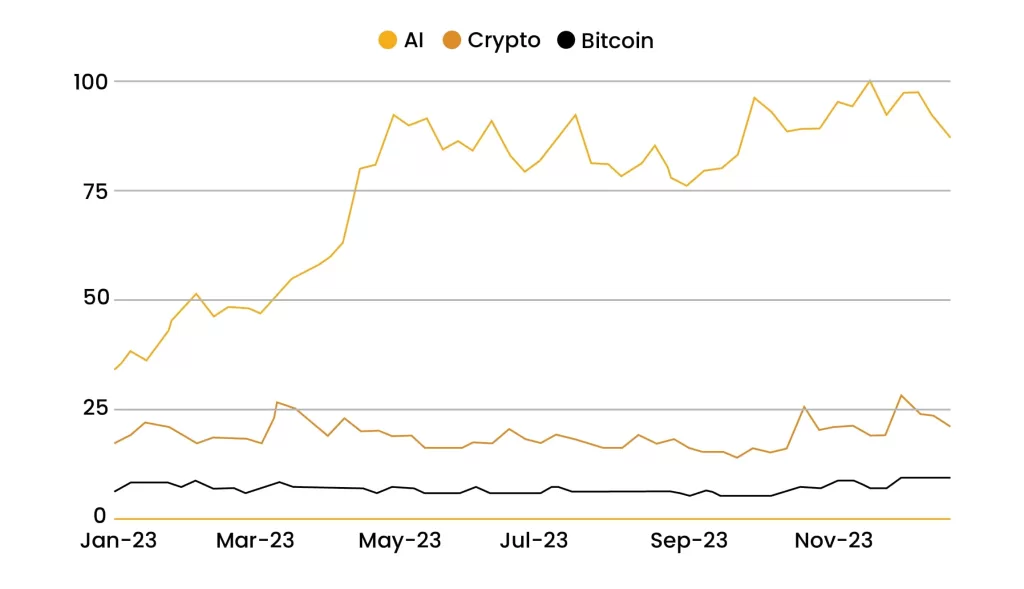
Source: Binance
The soaring interest in AI chatbots reflected a broader trend – a surge in public engagement with AI-related topics. Google searches for “AI” globally experienced a significant upswing, underlining a growing curiosity and desire to understand the intricacies of artificial intelligence. This heightened interest was not merely a fleeting trend but rather a sustained inclination fueled by the popularity of AI tools, increased media coverage, and a genuine thirst for knowledge about the world of AI.
While AI captured the public’s attention with an upward surge in interest, the crypto landscape, as indicated by searches for “Crypto,” remained relatively stable throughout the year. The search trends for “Bitcoin” mirrored the stability observed in the broader crypto landscape but with notable fluctuations. The volatility in Bitcoin’s interest was attributed to various narratives surrounding it, including discussions about Ordinals/BRC-20s, potential spot ETFs, and the looming halving event in 2024.
Rising Investor Interest
The AI sector demonstrated remarkable resilience in the face of changing market dynamics in 2023. Despite an overall reduction in funding amounts, AI’s share of US startup funding experienced exponential growth, surging by ~ 230% and accounting for ~ 26% of the total. This growth occurred against a backdrop where both AI and non-AI sectors faced a downturn in funding.
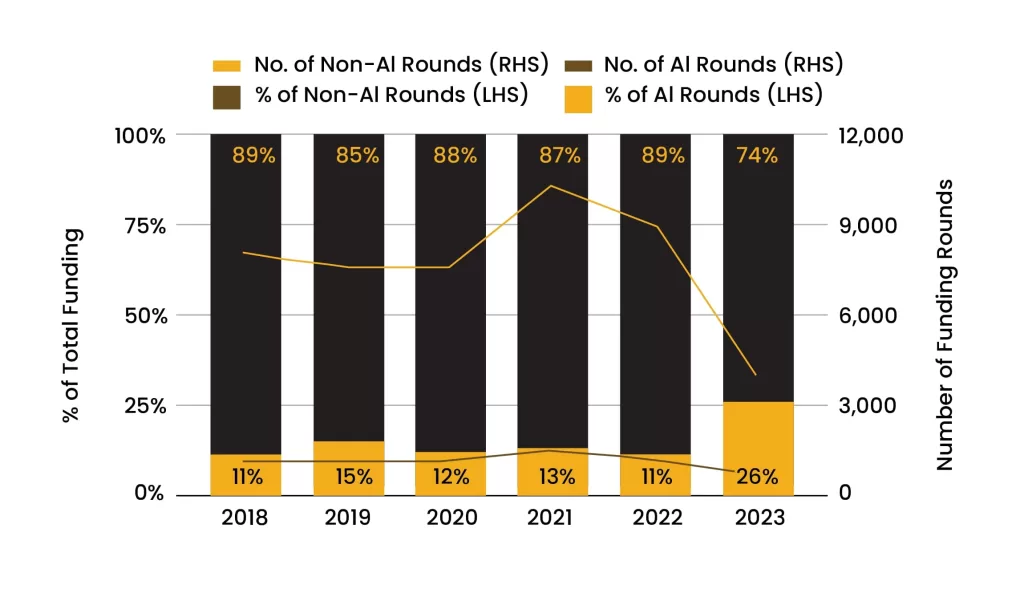
Source: Binance
The AI sector within the Web3 landscape saw explosive growth in terms of funding in 2023. There was a stark contrast between the overall funding for AI projects from 2016 to 2022 ~ $148.5 Mn and the funding amount in 2023 ~ $298 Mn. The funds raised in 2023 were double the total funding of the previous seven years, which highlights AI’s significant growth in 2023.
Performance of AI Tokens
AI tokens have demonstrated exceptional price performance in the cryptocurrency market, undergoing a substantial increase throughout the previous quarter and year. The rise in interest in the AI sector directly contributed to the robust performance of AI-related tokens, positioning them as a formidable force in the crypto space.
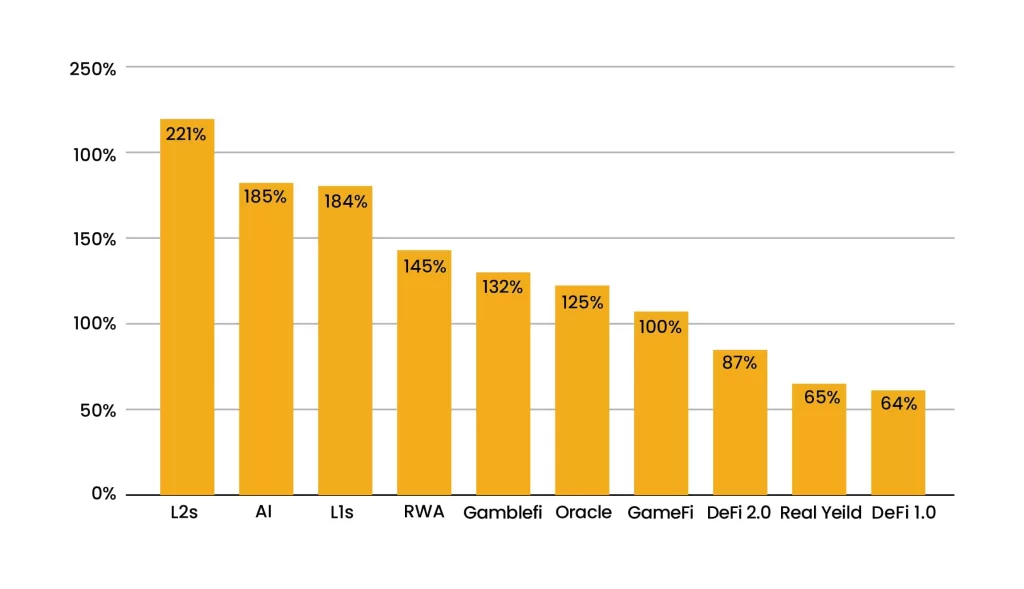
Source: Binance (AI Tokens Included: AGIX, CTXC, FET, OCEAN, ORAI, RNDR)
AI tokens have ranked as the second-best-performing category over the last three months. They also significantly outperformed the significant tokens like BTC and ETH in 2023, with one-year performance ranging from 200% to as high as 650% ($RNDR).
Major AI x Web 3 Developments
The surge in interest in AI in 2023 not only transformed the landscape of AI itself but also fueled the growth of AI-related crypto applications, leading to a symbiotic evolution of these two disruptive technologies. In this section, we delve into trends and tangible use cases that have emerged from the convergence of AI and crypto technologies.
DePIN: Decentralized Compute Networks
Large language models, deep learning, and various AI applications heavily rely on GPUs for computational power. However, the burgeoning interest in AI has led to an outsized demand for GPUs, resulting in a shortage of chips. The high cost of computing, coupled with the unavailability of GPUs, can be prohibitive for researchers and startups engaged in AI-related research.
This challenge gave rise to decentralized computing networks, a subset of which is known as decentralized physical infrastructure networks (DePIN). These networks provide an alternative to existing solutions dominated by centralized cloud providers and hardware manufacturers. The primary goal is to connect those with idle computing power to those in need, creating a two-sided marketplace that allows suppliers of computing power to receive incentives from buyers.
Examples of such decentralized computing networks include Render, Akash, and Gensyn, among others. Beyond the advantage of competitive pricing, these networks also address the issue of GPUs operating at less than 100% capacity all the time. By establishing a marketplace that connects suppliers and buyers, decentralized computing networks optimize the utilization of computing resources, creating an efficient and cost-effective solution.
ZKML: Zero-Knowledge Machine Learning
While smart contracts are known for their efficiency in code-based automation, they often lack adaptability in complex, unforeseen situations. This limitation has given rise to the integration of machine learning (ML) into smart contracts, providing a solution to enhance adaptability. ML models, trained on extensive datasets, possess the ability to learn, adapt, and make highly accurate predictions.
However, the integration of ML into smart contracts poses a challenge due to the computational overhead of on-chain ML computation. This challenge has led to the concept of Zero-Knowledge Machine Learning (ZKML). ZKML combines zero-knowledge proofs with machine learning, allowing off-chain ML computations while using zero-knowledge proofs to verify the integrity of these computations without revealing the actual data.
ZKML finds application in various areas, including Automated Market Makers (AMMs) optimized for pricing long-tail assets, AI-driven on-chain index funds with on-chain cryptography proofs, prediction markets focused on specialized topics, and more.
Consumer dApps: Transforming User Engagement
Over the past year, a notable trend has been the integration of AI into consumer-facing decentralized applications (dApps), revolutionizing user engagement. These applications leverage AI to increase interactivity and foster user participation, transforming the way users interact with platforms.
One such example is the emergence of AI user-generated content (UGC) platforms, exemplified by NFPrompt. AI UGC platforms allow users to create content with the assistance of an autonomous system. By inputting a set of rules or constraints, users can guide the AI algorithm to generate content based on the provided framework. This not only empowers users to participate actively in the content creation process but also establishes a more participatory relationship between users and the platform.
Beyond content generation, the integration of AI has profound implications for Web3 gaming or virtual worlds, where in-game characters become more interactive, and conversations take on a more lifelike quality.
Conclusion: The Symbiotic Future of AI and Crypto
The year 2023 has been a watershed moment for artificial intelligence, leaving an indelible mark on the technological landscape. The widespread use of AI chatbots, the resilience of the AI sector in the face of market fluctuations, and the symbiotic relationship between AI and the crypto market all contributed to the transformative journey of AI.
As we navigate the complex interplay between AI and crypto technologies, the coming years hold the promise of even greater innovation and convergence. It’s not merely a coexistence but a collaboration that propels both AI and crypto to new heights, promising a future where the boundaries between the two blur, creating a technological landscape rich with possibilities.





